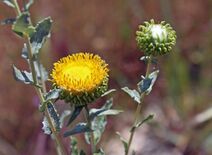Grindelia camporum
| Grindelia camporum | |
 | |
| Light: | |
| Moisture: | |
| Hardiness: | 8 |
| Soil pH: | 5.6-8.4 |
| Height: | 4' |
| Width: | 2' |
| Blooms: | Mid Summer-Late Summer |
| Native to: | |
| Nectary | |
| Medicinal Rating: | |
| Tea: | Yes |
Grindelia camporum (common name: gumplant)
Propagation: Seed - sow autumn or spring in a cool greenhouse and only just cover the seed. Prick out the plants into individual pots when they are large enough to handle and plant them out into their permanent positions in early summer.
Cultivation: Succeeds in any well-drained soil in full sun[1]. Does well on dry sandy banks and in poor soils[1].
This species is not hardy in the colder areas of the country, it tolerates temperatures down to between -5 and -10°c[1].
All parts of the plant have a balsamic odour[2].
Range: Western N. America.
Habitat: Dry banks, rocky fields and plains, low alkaline ground in California[3].
Medicinal: Gumplant was used by the native North American Indians to treat bronchial problems and also skin afflictions such as reactions to poison ivy[4]. It is still used in modern herbalism where it is valued especially as a treatment for bronchial asthma and for states where phlegm in the airways impedes respiration[4]. In addition, it is believed to desensitize the nerve endings in the bronchial tree and slow the heart rate, thus leading to easier breathing[4]. The herb is contraindicated for patients with kidney or heart complaints[4].
The dried leaves and flowering tops are antiasthmatic, anti-inflammatory, antispasmodic, expectorant and sedative[5][6][7][2]. The principal use of this herb is in the treatment of bronchial catarrh, especially when there is an asthmatic tendency, it is also used to treat whooping cough and cystitis[5][6][2]. The active principle is excreted from the kidneys, and this sometimes produces signs of renal irritation[5][2]. Externally, the plant is used to treat burns, poison ivy rash, dermatitis, eczema and skin eruptions[6][2]. The plant is harvested when in full bloom and can be used fresh as a poultice or dried for infusions etc[2].
A homeopathic remedy is prepared from the leaves and flowering stems[5].
Usage: Yellow and green dyes are obtained from the flowering heads and pods[8]. Aromatic.
A possible substitute for wood rosin, used in the manufacture of adhesives etc[9]. This report probably refers to the resin that covers the flower buds.
Pollinators: Insects
Soil: Can grow in light and medium soils.
Drainage: Prefers well drained soil.
Flower Type: Hermaphrodite
Known Hazards: Large doses used medicinally can irritate the kidneys[7].
Also Known As: G. robusta rigida.
Links
References
- ↑ 1.0 1.1 1.2 Huxley, Anthony. The New Royal Horticultural Society Dictionary of Gardening. MacMillan Press, 1992.
- ↑ 2.0 2.1 2.2 2.3 2.4 2.5 Bown, Deni. Royal Horticultural Society Encyclopaedia of Herbs and Their Uses. Dorling Kindersley, 1995.
- ↑ Munz, David. A California Flora. University of California Press, 1959.
- ↑ 4.0 4.1 4.2 4.3 Chevallier, Andrew. The Encyclopedia of Medicinal Plants. Dorling Kindersley, 1996.
- ↑ 5.0 5.1 5.2 5.3 Grieve, Margaret. A Modern Herbal. Penguin, 1984.
- ↑ 6.0 6.1 6.2 Usher, George. A Dictionary of Plants Used by Man. Constable, 1974.
- ↑ 7.0 7.1 Mills, Simon. The Dictionary of Modern Herbalism.
- ↑ Grae, Ida. Nature's Colors. MacMillan Publishing, 1974.
- ↑ Natural Food Institute. Wonder Crops 1987.